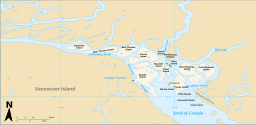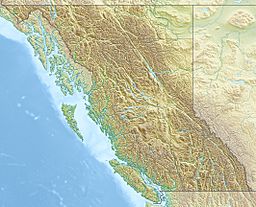Seymour Narrows facts for kids
Quick facts for kids Seymour Narrows |
|
|---|---|

Approaching Seymour Narrows from the north
|
|

Location of Seymour Narrows in the Discovery Islands
|
|
| Location | British Columbia, Canada |
| Coordinates | 50°08.2′N 125°21.2′W / 50.1367°N 125.3533°W |
| Type | Strait |
| Part of | Discovery Passage |
| Max. width | 750 metres (820 yd) |
| Average depth | 100 m (330 ft) |
Seymour Narrows is a narrow, 5-kilometer (3-mile) long section of water in British Columbia, Canada. It is part of the Discovery Passage, a waterway known for its very strong ocean currents. This passage is located between Vancouver Island and Quadra Island, and further north, Sonora Island.
The Seymour Narrows section starts about 18 kilometers (11 miles) from the southern end of Discovery Passage. This is where the passage connects to the Strait of Georgia near the city of Campbell River. The channel here is usually about 750 meters (820 yards) wide. Because it is so narrow, the water currents can become extremely fast, reaching speeds of up to 15 knots (28 kilometers per hour or 17 miles per hour).
Contents
What is the History Behind the Name?
The Seymour Narrows were named after Rear Admiral Sir George Francis Seymour. He was a high-ranking officer in the Royal Navy. He was in charge of the Pacific Station, a naval base, from 1844 to 1848.
Captain George Vancouver, a famous explorer, once described Seymour Narrows as "one of the vilest stretches of water in the world." This means he found it very dangerous and difficult to navigate. Even after a major underwater hazard called Ripple Rock was removed, the narrows still remain a challenging route for ships. For example, in March 1981, a large cargo ship named Star Philippine got stuck in the narrows.
How Do the Water Currents Work Here?
Seymour Narrows is also special because of how turbulent its water currents can be. Turbulence means the water moves in a very chaotic and swirling way. Scientists use something called a Reynolds number to measure this. In Seymour Narrows, the Reynolds number can reach about one billion. This is possibly the highest Reynolds number found regularly in natural water channels on Earth.
The water here can flow at about 8 meters per second (26 feet per second). The depth of the channel is around 100 meters (330 feet). Usually, water starts to become turbulent when the Reynolds number is around 2000. This depends on the shape of the channel. The extreme turbulence in Seymour Narrows makes it a unique place for studying water flow.
Seymour Narrows also marks part of the northern edge of the Salish Sea. The Salish Sea is a large network of coastal waterways that includes the Strait of Georgia, Puget Sound, and the Strait of Juan de Fuca.
What Was Ripple Rock?
A Hidden Danger to Ships
Ripple Rock was a dangerous underwater mountain with two peaks. It was located just 9 feet (2.7 meters) below the surface of Seymour Narrows. This hidden rock was a huge problem for ships trying to pass through. It caused 119 vessels to sink and led to the loss of 114 lives. One of the first ships known to be damaged by Ripple Rock was the gunboat USS Saranac in 1848.
The Plan to Remove Ripple Rock
To make the narrows safe, engineers decided to blow up Ripple Rock. This was a massive project that took 27 months of tunneling and engineering work. On April 5, 1958, they used 1,375 tons of a powerful explosive called Nitramex 2H. This was the largest commercial, non-nuclear explosion in North America at the time. The only larger explosion in Canada was the Halifax Explosion in 1917, but that was an accident, not a planned event.
The explosion of Ripple Rock was a huge event. It was even shown live on Canadian television. Footage of this historic moment is still regularly shown at the Campbell River Museum. The Vancouver band The Evaporators even wrote a song about the event. They released it on their 2004 album, which they named Ripple Rock.


